#low code no code development services company
Explore tagged Tumblr posts
Text
Application Development Services based on Low-Code/No-Code - Atharva system
Combining low code no code application development platforms with hand coding gives you full control while developing in Atharva System. Our solutions provide tailored solutions that drive efficiency and innovation and cater to every industry's unique needs.
#low code development platforms#low code platforms#low code no code#no code application development#low code development#low code app platforms#low code platform development#low code application development#low code app development#no code development platforms#low code application development platforms#low code software#low code no code development services company#low code no code development services#low code no code development company
0 notes
Text
The Rise of Low Code and No Code Development: Transforming the Future of Software Solutions
In today’s fast-paced digital world, businesses need software solutions that can evolve as quickly as their ideas. Traditional software development methods, though effective, are often time-consuming and resource-heavy. This is where low code development and no code development are making a big difference—empowering companies to build scalable, efficient applications with speed and precision.

What is Low Code and No Code Development?
Low code no code app development refers to platforms and tools that allow users to create software applications with minimal or no hand-coding. These platforms offer visual development environments, drag-and-drop features, pre-built templates, and automation tools, making app creation accessible even to non-developers.
Low code development: Ideal for developers who want to accelerate the process while still having the flexibility to customize code when needed.
No code development: Designed for users with little to no programming experience—enabling rapid development without writing a single line of code.
Both approaches drastically reduce development time and open up new opportunities for innovation.
Why Businesses Are Shifting Toward Low Code and No Code Solutions
There’s a growing demand for quick, agile, and cost-effective application development. That’s why low code software development has become the go-to approach for startups and enterprises alike. Here’s why it’s gaining popularity:
Faster time to market: Build and launch applications in days or weeks instead of months.
Cost-effective: Reduce the need for large development teams and long project timelines.
User-friendly: Business teams can participate directly in app creation, reducing the communication gap with developers.
Scalability: Ideal for MVPs, internal tools, and enterprise-grade solutions.
At CodeReady, we specialize in offering smart, scalable, and efficient low code and no code development solutions that help businesses launch faster and smarter.
Custom Software Development Still Matters
While low code and no code platforms offer speed and convenience, there’s still a strong case for custom software development. When businesses require advanced functionality, high performance, or deep integration with existing systems, tailored solutions are often the best fit.
At CodeReady Software, we bring the best of both worlds—blending low code and custom development practices to deliver solutions that meet your exact business needs.
Mobile and Web Development in a Low Code Era
The impact of low code tools isn’t limited to backend systems—it’s transforming mobile app development and web development solutions as well.
Mobile app development platforms now allow for rapid prototyping and deployment on both Android and iOS using low code tools.
Web development solutions can be launched with robust front-end and back-end features, optimized for performance and user experience, all through a simplified development process.
Our team at CodeReady Software leverages industry-leading platforms and frameworks to deliver high-performance mobile and web apps that are future-ready.
Final Thoughts: Choosing the Right Development Path
Low code and no code development aren’t just trends—they’re redefining how businesses build and scale technology. Whether you're a startup looking for a quick MVP or an enterprise seeking automation tools, these modern approaches offer unmatched flexibility.
However, for long-term growth, a hybrid strategy—combining low code software development with custom software development—often yields the best results.
If you're ready to accelerate your digital transformation journey, CodeReady Software is here to help. We offer tailored solutions in low code, no code, mobile app, and web development to bring your vision to life—quickly, efficiently, and with precision.
#no code app development#low code software development#low code no code development services#low code no code development company#low code no code platform#low code app development
0 notes
Text
Integrating ChatGPT with the Microsoft Power Platform could revolutionize how businesses develop and engage with their applications. This combination of advanced conversational AI and the versatile Power Platform enables organizations to create business apps that are not only powerful but also intuitive, helping companies enhance user experiences and automate critical processes more effectively. Microsoft PowerApps has become a cornerstone for businesses looking to develop custom applications quickly and with minimal coding. By integrating ChatGPT, companies can unlock new capabilities in their apps, allowing users to interact using natural language. This integration provides an innovative way to communicate with systems, retrieve information, and perform tasks, all through simple conversations. For example, users can ask a business app to generate reports, pull up customer data, or even schedule appointments, all by simply typing or speaking commands. This ease of interaction makes applications more user-friendly and efficient, especially for non-technical users. Regarding Power Apps development, integrating ChatGPT empowers developers to build more innovative apps with conversational interfaces. These apps can leverage AI to provide real-time insights, automate repetitive tasks, and even assist decision-making. An everyday use case for this integration might be customer service. ChatGPT can act as an intelligent virtual assistant to answer customer inquiries, suggest solutions, or provide status updates on support tickets. This improves overall productivity and satisfaction by cutting down on response times and freeing up customer support teams to concentrate on more complicated problems. Moreover, combining ChatGPT with Microsoft Power Automate takes automation a step further. Natural language interactions can automate routine tasks such as generating invoices, processing data inputs, and sending reminders. This reduces manual effort and ensures accuracy and consistency, freeing valuable resources for more strategic work. For businesses considering this integration, partnering with a Power Apps consulting firm can streamline the process and help maximize the potential of ChatGPT within the Microsoft Power Platform. These experts can assist in designing the app architecture, integrating AI features effectively, and ensuring that the app meets the business's unique needs. Whether enhancing customer support, optimizing internal workflows, or improving data management, integrating ChatGPT with Power Platform can significantly elevate the functionality and efficiency of business applications, paving the way for better results.
#microsoft powerapps#low code development#power apps consulting#power apps development#powerapps developers#buy power apps#hire powerapps developer#microsoft power apps development#microsoft power platform consulting#microsoft power platform solution#microsoft powerapps consulting services#microsoft powerapps development company#power apps development services#powerapps consulting services#best microsoft powerapps consulting services#powerapps development company#low code app development services#microsoft power apps consulting#microsoft power apps solutions#microsoft powerapps service#microsoft powerapps services#power apps developers#power apps integration#power apps services#top microsoft powerapps development company#top microsoft powerapps consultants
0 notes
Text
Low-Code Development Made Simple: A Step-by-Step Guide

In a world where rapid innovation and digital transformation are paramount, traditional software development methods may often lead to bottlenecks and delayed project timelines. Here, low-code development emerges as a solution, allowing organizations to build applications quickly and efficiently through visual interfaces and minimal coding.
Wondering how low-code development differs from traditional methods? Read on to explore the differences, key stages, and strategies for a smooth low-code experience.
Why choose Low-Code Development?
Here’s a table explaining why many prefer low-code development over traditional methods:
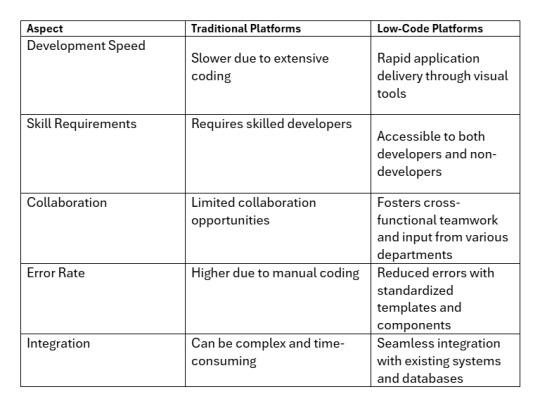
Hope you now ha’ve a clearer understanding of your next steps! Now, let’s explore the key stages of the low-code development journey.
Key Stages in the Low-Code Development Journey
Navigating the low-code development journey involves several essential stages to ensure successful application creation. Let’s break down these stages using the example of developing a mobile fitness application.
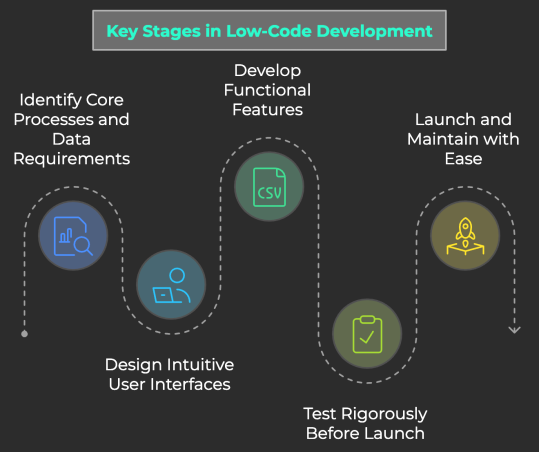
1. Identify Core Processes and Data Requirements: Before building your fitness app, it’s crucial to clarify the core processes that will drive user engagement. For instance, you might want to include features like workout tracking, diet logging, and user progress monitoring. Mapping out these processes helps you determine the data needed, such as user input, activity metrics, and nutritional information, in this case.
2. Design Intuitive User Interfaces: Next, think about how users will interact with your app. For a fitness application, you’ll need user-friendly interfaces for logging workouts or meals. Low-code/ no code platforms enable you to design these interfaces effortlessly using drag-and-drop functionality, allowing you to create customized fields that cater to user needs, such as exercise type, duration, and calorie intake.
3. Develop Functional Features: With your processes defined and interfaces in place, it’s time to construct the app. Low-code development empowers you to build robust features without extensive coding. For example, you can integrate a workout schedule that automatically adjusts based on user preferences, leveraging pre-built components to save time while enhancing functionality.
4. Test Rigorously Before Launch: Before launching your fitness app, thorough testing is crucial. Simulate user interactions to identify any technical issues or bugs. Low-code development platforms often provide testing environments where you can evaluate app performance under various scenarios.
5. Launch and Maintain with Ease: Once testing is complete, you’re ready to launch your fitness app. Low-code solutions simplify this process, allowing you to publish your application on various app stores with just a few clicks.
Additionally, these platforms facilitate ongoing updates and feature enhancements, enabling you to respond quickly to user feedback and keep your app relevant in a fast-paced market.
Onwards toward knowing about the hurdles and ways to dodge them!
Strategies for Overcoming Low-Code Development Challenges
Here are three common challenges along with their solutions to help you navigate the low-code journey effectively:
a. Limited Customization
Challenge: Low-code platforms may restrict customization, making it difficult to meet unique business needs.
Solution: Choose a flexible platform that allows for custom coding when necessary, enabling tailored solutions without compromising speed.
b. Integration Issues
Challenge: Integrating low-code applications with existing systems can be complicated, risking data flow and compatibility.
Solution: Select platforms with robust integration capabilities and APIs to facilitate seamless connections with other systems.
c. Governance and Security Concerns
Challenge: Increased access to development can lead to governance and security challenges.
Solution: Implement strict governance frameworks and security protocols to manage user access, data protection, and compliance effectively.
That’s all! By following these key stages and addressing the challenges in your low-code development journey, you can streamline your processes and create impactful applications that meet your user’s needs.
Learn more about cutting-edge tech developments with us at Nitor Infotech.
#application development#app softwares#mobile app development#mobile development company#low code#no code#software services#software development#blog#software engineering#Low-Code Development
0 notes
Text
How should you maximize efficiency with no-code and low-code development? In this article, learn how to boost efficiency, empower users, and future-proof development for fast and responsive website.
#web optimization service#low code no code#no code development#no code developer#web optimization company#webflow no-code development
0 notes
Text
In the fast-moving business world, staying ahead often means being open to new and creative solutions. One such powerhouse is Microsoft's PowerApps. Today, let's take a journey into the realm of PowerApps development, exploring how it can be a game-changer for your business.
Introduction: Unleashing the Potential of PowerApps
Imagine a world where creating custom business applications doesn't require a coding wizard. That's the promise of PowerApps. In this article, we'll unravel the layers of PowerApps development, examining its benefits, drawbacks, and the transformative impact it can have on your business.
#powerapps development company#powerapps development services#microsoft powerapps#app development company#low-code app development#software outsourcing#software development
0 notes
Text
Revolutionizing Enterprises: Raqmiyat's Trailblazing Role in Digital Transformation Services in Saudi Arabia
In today's swiftly evolving business landscape, the quest for digital innovation has become paramount. Enterprises are navigating through the digital transformation journey at an unprecedented pace. Raqmiyat stands tall as one of the leading digital transformation companies in Saudi Arabia, spearheading the revolution with its groundbreaking solutions and services. Embracing Digital Evolution: The essence of Raqmiyat's impact lies in its commitment to empowering enterprises with avant-garde digital technologies. The company's approach revolves around fostering a seamless transition towards digitalization. As the digital age unfolds, Raqmiyat provides a comprehensive suite of services tailored to propel businesses into the realm of success. Low-Code Development Platforms: At the forefront of Raqmiyat's offerings are their low-code development platforms. These platforms enable enterprises to construct and deploy robust applications swiftly. The flexibility of these platforms allows for easy integration with existing systems and the incorporation of custom code when necessary. Raqmiyat ensures that businesses remain agile and future-proof in a rapidly changing technological landscape. Robotic Process Automation Services: Raqmiyat's expertise extends to Robotic Process Automation (RPA), a game-changer in optimizing operational efficiency. By automating repetitive tasks, RPA liberates human resources to focus on core business functions. Whether it's accelerating customer service, processing transactions, or enhancing fraud detection, RPA streamlines operations for enhanced productivity. Enterprise Digital Transformation Services: The spectrum of Raqmiyat's enterprise digital transformation services is vast. From enterprise mobility solutions to digital UI/UX services, Raqmiyat enables seamless connectivity and innovative solutions. The company specializes in dissolving process silos, fostering better decision-making, and catalyzing faster innovation within enterprises. A Trail of Recognitions: Raqmiyat's dedication and excellence have garnered recognition in the industry. The company proudly holds accolades such as the "Best Digital Solutions Provider of the Year" at the Future Enterprise Awards 2021 and the "Best Automation Solutions Provider" at The Transformational Leadership Awards 2020. Additionally, being awarded the "Enterprise Mobility Vendor Of The Year" in 2020 testifies to Raqmiyat's unwavering commitment to digital innovation. Shaping the Future: As businesses traverse the path of digital transformation, Raqmiyat remains a steadfast partner, steering enterprises towards a future ripe with possibilities. Through their innovative solutions and unwavering dedication, Raqmiyat continues to redefine the landscape of digital transformation services in Saudi Arabia, ensuring that businesses not only survive but thrive in the digital era. In conclusion, Raqmiyat's impact on Saudi Arabia's digital transformation landscape is undeniable. As businesses embrace the wave of technological evolution, partnering with a company like Raqmiyat becomes not just a choice but a necessity to thrive in the digital age.
#digital transformation companies in saudi arabia#low code development platforms#robotic process automation services
0 notes
Text
Maybe it isn't that I actually hate medical professionals? They just suck and are weird sometimes, and a lot of them shouldn't be practicing, but I don't hate them as a group, like, personally.
What I hate is their ability to make my life harder in ways that are often completely opaque to me, and a lot of the crap things they do are not really possible to challenge. And I hate the fact that holding them responsible fort dogshit behavior in any way that will actually benefit me is almost always impossible.
And I also hate the fact that they have to do stupid things sometimes because that's how the system is set up, and those things sometimes mean patients actually get harmed. They aren't fond of that part either! They don't want the system to be the way it is! But they don't have a choice, so sometimes people like me get forced by bureaucracy into doing things that are re-traumatizing. And I can't imagine that feels good for them at all, knowing that their patients are sometimes only "consenting" because that bureaucracy will not let them be helped in any other way. Which isn't consent at all. I imagine that must be pretty traumatizing for them, too, sometimes.
If it were easier to actually access medical care without tremendous delays in this country right now I would have much less trouble finding providers who are good at what they do and are not horrible people, and who have clinic staff who can do their fucking job.
Oh and I also don't appreciate how evasive and unwilling to commit they are out of fear of being held to an answer that turns out to be inaccurate, but I can't make an informed decision about my own care unless they give me at least some information about probabilities and trajectories and typicalities. Genuinely, how the fuck am I supposed to navigate that shit. I get that some patients are really fucking difficult, but I should be able to get a special stamp on my file or something that says I understand that sometimes medicine isn't an exact science and the best answers that my doctors can give may not always prove to be accurate in the long term. I know they don't like being in that situation either.
A lot of medical professionals are fucking assholes, and unfortunately the ones who are not are still hamstrung by a system set up to actively prevent people from getting care.
I miss my old doctor. He gave no shits about anything that wasn't the patient. He prescribed scheduled meds based on what the patient needed and not based on fear of consequences potentially being imposed on him by the punitive patient-hostile drugs-are-bad moral panic machine developed to force suffering people into buying more dangerous drugs off the street in order to prevent far fewer people from maybe getting high off of drugs that at least weren't laced with lethal substances. (The purpose of a system is what it does.) Did he get sanctioned and become locally unhireable? Unfortunately yes he did. Does he now provide concierge care to rich people? Yes he does. He found a way to make it work, God bless him.
Everything about the medical system in this country is fucked. Hospitals, doctors, nurses, pharmacies, pharmacists, pharmacy techs, phlebotomists, clinic administrative staff, insurance companies, medical schools and schooling, licensing boards, drug advertising to both providers and patients, pharmaceutical reps, researchers, research, publishing, medical trials, pharmaceutical companies, manufacturers and distributors, medical equipment, charting software, billing and billing codes, diagnostic criteria, charity and low income services, accessible transportation, home care, the lack of independent individual patient advocates, dietitians and nutritionists, access to physical and occupational therapy and physical and occupational therapists, the massive bigotry of every kind rampant in every corner of the medical field, social work, senior care and assisted living, deprioritization of informed consent and harm reduction, disability applications, inaccessibility of medical records, especially psychiatric notes which are specifically allowed to be withheld from patients, lack of continuity of care for disadvantaged people, care that is equitably accessible to disabled people, telemedicine, patient portals, phone systems, clinic hours, every single aspect of inpatient and outpatient psychiatry, facility security, all sorts of things going on with therapists who are nevertheless probably the least malicious group of people in this entire charade, aaaaaand patients themselves.
Also hospital toilets that are too tall and make it literally physically impossible for me to poop while I'm there waiting for somebody to come out of surgery. I just needed to take a crap, guys. You didn't need to make the toilets so tall that my feet didn't even touch the floor. It is very clean but there is no shitting for short people at St Francis.
353 notes
·
View notes
Text
One way to spot patterns is to show AI models millions of labelled examples. This method requires humans to painstakingly label all this data so they can be analysed by computers. Without them, the algorithms that underpin self-driving cars or facial recognition remain blind. They cannot learn patterns.
The algorithms built in this way now augment or stand in for human judgement in areas as varied as medicine, criminal justice, social welfare and mortgage and loan decisions. Generative AI, the latest iteration of AI software, can create words, code and images. This has transformed them into creative assistants, helping teachers, financial advisers, lawyers, artists and programmers to co-create original works.
To build AI, Silicon Valley’s most illustrious companies are fighting over the limited talent of computer scientists in their backyard, paying hundreds of thousands of dollars to a newly minted Ph.D. But to train and deploy them using real-world data, these same companies have turned to the likes of Sama, and their veritable armies of low-wage workers with basic digital literacy, but no stable employment.
Sama isn’t the only service of its kind globally. Start-ups such as Scale AI, Appen, Hive Micro, iMerit and Mighty AI (now owned by Uber), and more traditional IT companies such as Accenture and Wipro are all part of this growing industry estimated to be worth $17bn by 2030.
Because of the sheer volume of data that AI companies need to be labelled, most start-ups outsource their services to lower-income countries where hundreds of workers like Ian and Benja are paid to sift and interpret data that trains AI systems.
Displaced Syrian doctors train medical software that helps diagnose prostate cancer in Britain. Out-of-work college graduates in recession-hit Venezuela categorize fashion products for e-commerce sites. Impoverished women in Kolkata’s Metiabruz, a poor Muslim neighbourhood, have labelled voice clips for Amazon’s Echo speaker. Their work couches a badly kept secret about so-called artificial intelligence systems – that the technology does not ‘learn’ independently, and it needs humans, millions of them, to power it. Data workers are the invaluable human links in the global AI supply chain.
This workforce is largely fragmented, and made up of the most precarious workers in society: disadvantaged youth, women with dependents, minorities, migrants and refugees. The stated goal of AI companies and the outsourcers they work with is to include these communities in the digital revolution, giving them stable and ethical employment despite their precarity. Yet, as I came to discover, data workers are as precarious as factory workers, their labour is largely ghost work and they remain an undervalued bedrock of the AI industry.
As this community emerges from the shadows, journalists and academics are beginning to understand how these globally dispersed workers impact our daily lives: the wildly popular content generated by AI chatbots like ChatGPT, the content we scroll through on TikTok, Instagram and YouTube, the items we browse when shopping online, the vehicles we drive, even the food we eat, it’s all sorted, labelled and categorized with the help of data workers.
Milagros Miceli, an Argentinian researcher based in Berlin, studies the ethnography of data work in the developing world. When she started out, she couldn’t find anything about the lived experience of AI labourers, nothing about who these people actually were and what their work was like. ‘As a sociologist, I felt it was a big gap,’ she says. ‘There are few who are putting a face to those people: who are they and how do they do their jobs, what do their work practices involve? And what are the labour conditions that they are subject to?’
Miceli was right – it was hard to find a company that would allow me access to its data labourers with minimal interference. Secrecy is often written into their contracts in the form of non-disclosure agreements that forbid direct contact with clients and public disclosure of clients’ names. This is usually imposed by clients rather than the outsourcing companies. For instance, Facebook-owner Meta, who is a client of Sama, asks workers to sign a non-disclosure agreement. Often, workers may not even know who their client is, what type of algorithmic system they are working on, or what their counterparts in other parts of the world are paid for the same job.
The arrangements of a company like Sama – low wages, secrecy, extraction of labour from vulnerable communities – is veered towards inequality. After all, this is ultimately affordable labour. Providing employment to minorities and slum youth may be empowering and uplifting to a point, but these workers are also comparatively inexpensive, with almost no relative bargaining power, leverage or resources to rebel.
Even the objective of data-labelling work felt extractive: it trains AI systems, which will eventually replace the very humans doing the training. But of the dozens of workers I spoke to over the course of two years, not one was aware of the implications of training their replacements, that they were being paid to hasten their own obsolescence.
— Madhumita Murgia, Code Dependent: Living in the Shadow of AI
71 notes
·
View notes
Text
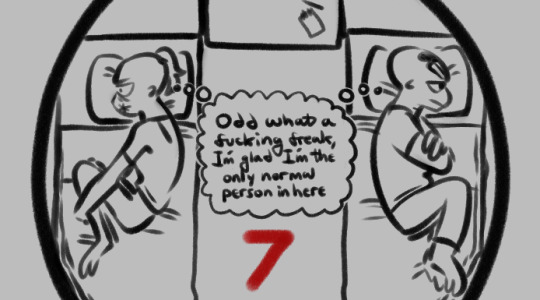
MISERY LOVES COMPANY: chapter 7
as the sword of damocles hangs over abe's head, howler comes to the conclusion that this mud can't be fixed. but, she knows something else that can calm him down.
chapter cw for: some molluck-based sexual harrassment, mildly sexual content
[first]|[prev]
-
Abe winced from the heels digging into his back; unable to shift his position and make his predicament any more comfortable. The only reprieve that being made to heel in front of Molluck gave him was that his head was underneath the thick cloud of smoke that settled in the room, contributed to by Molluck’s chain smoking.
The Glukkon had been too busy to pay attention to him today, burning through his cigars on back to back conference calls with investors. Abe tried to tune out the one-sided business jargon, and attempt to dissociate from this boring, uncomfortable ordeal. If he wasn’t being used today, then why the hell was he even here?
He could have at least let him keep his clothes on. But he supposed there was another layer of humiliation and domineering to be had in having a nude, prone Mudokon act as a living footstool. Every once in a while Molluck would kick him, or gore him in the ribs with his heel, just to elicit a pained response from his victim. He did that whenever he was frustrated, which was often.
There would be no payoff or reward for being toyed with like this, such was the case with every moment Abe was forced to personally service the Glukkon. According to Molluck, the ordeal was the reward - the respite from working in the hot, rotting pit of the factory floor below them. The privilege to be in a Glukkon’s grand office, where the air was clean and comfortable, and the noise of the machinery was blotted out. The luxury of kneeling on the expensive, plush carpet, which felt more comfortable than Abe’s own mattress against his bare legs. And of course, there was the attention from the boss himself. Attention without affection, or pleasure. Attention Abe was made to thank Molluck for, after every new mark he placed on him.
In the back of his mind, Abe knew this was wrong, that this wasn’t fair - but was it really wrong when it was the way things have always been? And if things have always been like this, was it really in his place to protest? There was no changing this. This was his place in the world: here. The floor. Bare, bent over. Shoes worth more than his life tenfold resting heavily between his shoulder blades.
‘The chosen people’. What a ridiculous concept. ‘They were afraid of us’. Afraid of what? What was there for a man like Mullock to fear in the ragged, overworked masses of his workforce?
‘He is just a man’, but to a lowly thing like Abe he may as well have been a god.
‘Men can be killed’.
Where was her proof of that?
Abe sighed in relief when Molluck removed his shoes from his back, if only for a moment to reach a floor pedal that would switch his telephone to the next line. Dull placations for one investor turned into curt, irritated barks at another flawlessly. Abe had pieced together context from what he overheard: the paramite shortage was leading to concerns about another ‘meech situation’, so Molluck was trying to pitch a new product for their interest. Whatever it was, it seemed pretty hush-hush; Molluck practically talked in code, his voice dripping with innuendo whenever he described whatever frozen treat that he had in development.
Though his back was turned, there were times when Abe could swear Molluck was staring at him the entire time he went on about new ways to peddle meat. There was a low note of hunger in the Glukkon’s voice, not dissimilar from when he would hiss carnal orders to his subordinate.
Abe had become accustomed to the Glukkon’s comparisons of him to the very kind of food RuptureFarms sold. He barely batted an eye towards Molluck’s dark, perverse sense of humor these days, now that the shock of his treatment had worn off and he settled into dull, grim acceptance of his role as the ‘favorite’. To be referred to like meat was probably the closest thing to a compliment he was going to get.
Molluck ended his call in a more irritated mood than before, and took it out on Abe by digging his heel into the Mudokon’s spine. Pain lanced through the prone man, causing him to freeze up in agony. Abe clutched handfuls of carpet fibers, and tried to stay quiet. The low chuckle from behind him at least told him he was serving his purpose.
Entertainment.
A shoe nudged Abe harshly in the shoulder. “Geddup.”
Abe rose to his feet with a click of his stiff knees. He turned to his boss, careful to not give into the impulse to cover himself with his hands. He hadn’t given a thought to nudity before all this; now he was hyper-aware of every bone and sinew that stuck out under his dry, dull skin. Mostly because that was where Molluck’s eyes went, gaze trailing a familiar pattern down the front of the man before him. His collarbone, his ribs, the jutting points of his hips. Whatever Molluck saw in him was something Abe didn’t see. It probably wasn’t even his body. It was probably just the concept of him - the subservient, the downtrodden, the most pathetic out of an army of already pitiful scrub stock.
Or maybe it was something else. Something deeper. The ‘chosen people’, reduced to this, utterly cowed, now a victim humiliated before those who once had reason to fear them.
As Molluck ordered him to open up the front of his suit, Abe thought longingly of the moon.
-
As had become a new routine, Howler gave her roommate a desperate look as she tapped her lips. Abe sighed, tired of having the same answer for her question every time.
“...Not today, Howler.”
She looked a little crushed every time, and that made him feel worse than if she actually got mad at him. He already told her up front that there wasn’t any chance he could steal anything from Molluck’s office - even if he had the opportunity to swipe that pin, he was also often naked, and he was not taking Howler’s suggestions on where to hide it.
Abe flopped onto his uncomfortable bed, still in his work clothes. The factory was sweltering today, and the provided uniforms weren’t breathable in the least, but he found himself grateful that he at least got to wear them here. Howler was more than likely already naked under her bedsheets, her own modesty decidedly more lax around the scrub she trusted to not overstep her boundaries.
Already settled in the cot across from him, Howler clicked her tongue to get his attention. With an unreadable expression she made a lewd gesture; miming giving a handjob to someone else. Abe scoffed softly, and corrected her by miming fellatio. The muted woman gave him a grim nod of understanding.
“He was so pissed off today, I’m just glad it wasn’t anything more than that.” Abe rubbed where his jaw was still sore. He could wash his mouth out as many times as he liked, but he could still feel it.
Howler opened her personal drawer, and rooted around in her hoarded ‘gifts’ until she could slide a half-finished roll of mints across the chest of drawers. Abe, despite himself, despite everything, laughed. Something about the casual, almost pragmatic way she approached their similar situations brought some sense of levity. It was grounding, almost.
There was simply no way he could tell anyone else, but he could tell her. Cautiously, at first; uncertain how to describe such things when sexuality as a whole was still practically alien to him. She listened to him, and not because she couldn’t talk back. She actually listened, and that wasn’t something he thought he was ever going to get, anywhere.
In the back of Abe’s mind, he still darkly wondered what she was getting out of this. Whether this kindness, this connection was simply a means to an end for her. She just wanted her voice back, and out of all the scrubs in this pit it was Abe that regularly visited the room her voice box switch was kept in… to see the Glukkon that hoarded it.
With the idea of stealing it remaining impossible to the downtrodden scrub, Abe just wondered how long Howler was going to keep up pretending to be nice to him.
The heat of the factory didn’t abate even as night fell, so Abe was forced to shed his work clothes if he wanted even a sliver of comfort. He shivered from the air hitting his bare skin upon pulling off his undershirt; the feeling of exposure taking him briefly back to the office. That sickly feeling of vulnerability, the feeling of Molluck’s leering, seeming to strip away more than just his clothes. He stopped midway, his arms still tangled up in his shirt. His thoughts felt distant; removed from his mind and his body, which remained still as he lost himself in that proverbial fog.
The mostly inside-out shirt being pulled from his forearms snapped Abe back into reality. Howler finished undressing him, pulling down his overalls to his ankles, leaving him in his boxers much like she was. Abe still felt distant as she guided him to lay down in his cot. He was there, yes, but he couldn’t move beyond what Howler urged him to do. He complied limply, and when his back hit the mattress the weight of his own flesh and bone pinned him to it.
When he could focus his vision again, Abe saw the grim concern on Howler’s face. The idea of worrying her snapped a little more of him back into his body, enough to place a paw on her wrist.
“I’m fine,” he mumbled, less as a reassurance and more a bid for her to stop. She gave him a skeptical frown. His paw enclosed hers; calloused and riddled with scars from working so close to bladed machinery his whole life. Hers was softer, unblemished, not allowed to become hard and wiry and dry like the rest of the scrub. In time, maybe he would see her paws would become as gnarled as his, if she survived. If they both survived.
Abe didn’t expect Howler to squeeze his knuckles back, when he tried to pull away and found her resisting. It wasn’t forceful, but it was unfamiliar. Everything she did was unfamiliar, but with her the foreign physical contact didn’t feel coerced, nor violating. It felt like something he simply didn’t know how to ask for, or could possibly know he wanted.
He still couldn’t discern if he wanted this, or if he wanted her, or anything. All he could really articulate within himself was that he wanted to feel safe, and she was, in what ways she could, conveying that to him.
It was so… nice. But as with all nice things Abe knew it would be temporary, and his ruminating thoughts dwelled on just how long this comfort would last. How long she would put up with him. One of these days, he was going to come back to their pod to find her side cleaned out, stripped bare of any proof she even existed. And he was going to have to get up the next morning, and start his shift like any other day.
Why did it all feel so finite? It felt like there was a clock counting down, and he started hearing its ticking the moment he saw a glimpse of the night sky and its reality.
Abe swallowed to wet a dry, scratchy throat. Words escaped from behind his stitches before he could acknowledge he was saying them. “I should have never shown you that skylight, now it’s all I can think about.”
Howler cocked her head curiously. Her unoccupied paw reached up to brush her thumb against his face, and the scrub shied away from the contact. He tried to look at anything but her.
“I wish I never saw that… whatever it is… on the moon. I wish you never told me about it. I don’t… I don’t want to escape, or anything like that. Ther- there’s nothing out there. Right?”
Just mentioning it made his pulse quicken, that spike of anxiety rising all over again. That fear, directionless but all-consuming, like a prey drive overloaded around constant predation. At least, it had to be fear, because that was the closest feeling Abe could compare it to. Anticipation, anxiousness, dread. Feeling like his life was on the line, like he was going to die.
“I’m supposed to be here. RuptureFarms is my home. There’s nothing out there, so it wouldn’t be worth it to leave. So why can’t I stop thinking about it?”
If there was anyone who would have this answer, it would have been her. It had to be her. Abe looked desperately into Howler’s eyes to see no warmth or reassurance, just distant pain. Her expression twisted with grief, and for a moment she looked towards her notepad left on the table. She hesitated, and thought better of it with a frustrated huff. Whatever she could say was either too complicated, or too hurtful to write.
She instead opted to lay down on the unoccupied sliver of cot beside him. She pulled him close, and Abe felt as limp as a carcass as he let her. The warmth of her bodyheat broke through the dissociative numbness that still entrapped him, and he found himself curling into the comfort she offered.
It wasn’t an answer, but maybe he wasn’t ready to hear one. Maybe he didn’t really want to hear an answer, because either option he could think of felt equally paralyzing. He shouldn’t leave, because here in this factory was where he was born to be. But he should leave, because out there was where he was meant to be.
Abe didn’t know what was out there that could possibly be for him. But here, he could think of at least a few things. Howler, for better or worse, was here. That was something.
As stuffy as the fetid factory air was, they were both at once overheated and clammy. Mostly bare, their skin slightly sticky in the oily way the Mudokon body attempted to keep from drying out in these conditions. Wherever Abe’s body wasn’t in contact with Howler’s grew cold, and what parts that did were sweating. The heat of their chests together wasn’t entirely unpleasant, but the awareness of their near-nakedness stirred the complicated cocktail of shame and embarrassment Abe always felt when he acknowledged Howler’s body.
He wasn’t afraid to touch her, but he felt guilty at the thought of it. Everyone else wanted her: her body, her role and purpose as a ‘queen’. The novelty of her womanhood, an abstract concept that the rest of the scrubs had only a vague notion of. Abe didn’t react towards her like the others, and though he was used to feeling like the odd mud out, this particular difference made him feel wrong.
Well, there were a lot of things making him feel ‘wrong’, lately. This was just one factor, but at least it distracted him from the existential dread he shouldered as of late.
Abe laid still, but awake. He watched under heavy-lidded eyes as Howler relaxed, and settled into a position comfortable enough to fall asleep. It was odd that she didn’t return to her own bed, but her roommate didn’t mind, as he took up so little of his own cot anyways. They were already in such close quarters, the closing of that physical gap didn’t feel as jarring as he thought it would. Not that he was thinking of that before.
Maybe he was thinking of it a little.
It actually felt better than he imagined.
-
Abe wasn’t the worst person to wake up next to. But Howler still felt a pang of disappointment in herself when she awoke, bare to the world, with an equally undressed scrub clinging to her. It took her a moment to remember the hours prior. The circumstances that led to this weren’t so bad, so she could use that as an excuse to linger there.
Howler laid there with an arm around the poor, miserable mud. Guilt coiled within her as she remembered his hushed, wavering confessions. She had cursed him with the same misery she had to live with, and he didn’t even have a life before his servitude. No tribe, no family, no promise of some role or destiny to speak of. Nothing to miss, nothing to ache for.
And yet, she saw within his eyes herself. Her in her own lowest point of despair, the one that she passed years ago. The realization, the grieving, and later the acceptance of her fate. The cage she had been forced into had become her life, but she would cling to the fact that it was not her world. Abe, born into that cage, had been raised to see it as his - but now he couldn’t, not anymore.
Howler had seen stronger, tougher correctives than her break under the realization that they would never be ‘saved’. A scrub would have no concept of a savior, so they were spared, in a sense, of that pain. At least, that had been what Howler was taught of their kind. A mud whose entire world was the factory they were born into would want for nothing but the factory, as long as they never saw what lay beyond.
Abe would bear that burden of knowing there was something beyond, alongside her. And it was entirely her fault.
Unable to apologize with words, Howler hoped that her comfort would at least suffice. It seemed to be helping, from the blue mud’s blissful expression as he slept against her chest. With any other Mudokon it would have looked deliberately provocative, with his face buried between her rows of breasts; but, knowing Abe, he probably genuinely didn’t know what he was nuzzling against.
Howler could deal with that freakout later. Right now, it was so… nice, to feel so at ease around a man. To let herself relax, without risking her security. To simply not have to be in control of the moment, and not fear that control passing to someone else. Abe would probably agree.
It would be a few hours still before the day officially began, and Howler intended to doze off again in this state of bliss she found herself in. Instead, Abe stirred against her. The tattooed mud froze.
For a moment, Abe sunk deeper into the crevice her cleavage made, before he came to his senses enough to abruptly pull back. His eyes widened in dawning horror, like he had been using a bee’s nest as a pillow this entire time. He flinched when he heard Howler scoff, and immediately tried to shy away with some mumbled apology.
Before he could roll over to face away from her, Howler tugged on his feathers. He faced her with a profoundly guilty look that made her pause, which she questioned with a one-shouldered shrug.
Abe’s blush looked purplish under his depressive blue. “Sorry, I just… Sorry.” The fact that she wasn’t making a move to cover herself had him pointedly looking away.
Howler put a hand on his shoulder, and got him to look at her. She took his hand, and held it in a reassuring way, trying as clearly as she could to convey that it was okay. This was okay, he was okay. As annoying as his skittishness was, Howler remembered when she was just as bad.
Slowly, deliberately, she brought his hand just short of her topmost breasts, hovering it over her exposed skin. Her tattooed brows raised with an inquisitive look. Abe struggled to parse what she was trying to say, but what he was starting to understand was making him sweat.
“I’m, I,” Abe swallowed, and licked his stitches along with his dry lips, “I don’t… I don’t know. If I want to.”
He practically let out a sigh of relief when she unhanded him. Howler reached over the dresser and grabbed her notepad.
‘Do u want to no?’
Abe gawked at the question she showed him, and for a moment it looked like he was about to answer with a second, even more distressed ‘I don’t know’. But he stopped himself, this time, and answered instead in the most uncertain tone,
“I think so?”
23 notes
·
View notes
Text
Things that are horrendously and embarassingly bad about sse/sso:
Game code and glitches and bugs
Weekly update schedule
Community management
This kind of falls under all three but generally Every part of the game feels unfinished and detached from the rest. Quests don't match up. Basic visual objects (clothing, tack) glitch through each other. Added content is frequently blatantly untested.
I'm not even diving into the dynamics within the company itself.
Or its horrendous marketing.
Also in game items have big inflation problems. Largely caused by the fact that the max amount of js a player can carry at any given time is capped at an amount you can max out in a day or two, which is automatically also a Very Low maximum that you can price an item.
The half-hearted retrofitting whenever they update a part of the game. Horse speed breaking quests. Retrofitting new tack to basic horses. This kind of ties back into point number one.
Things that I Genuinely Like about SSO/are done really well/have no better alternative in the games industry:
Sound design? I feel like people don't talk about this enough. Not just the music but also atmospheric elements are really well done, even if the game struggles with sound triggers sometimes. I especially like the horse-related sounds, as stupid as it sounds. If i can ride a horse in a video game I'm judging it by the noises the horse's hooves make. SSO is like right below tears of the kingdom in that for me.
Map design: It's frankly very impressive how every spot in Jorvik has really good views, and the balance between feeling like places are miles away and giving you excellent traveltime, while still being dense with locations and quest opportunities. Epona feels like three days of travel away, and yet from the right spot you can simply see the castle on the other side of the water!
Individual visual design: I like the look of the new player models (put your nostalgia goggles away. the old shit looks like it belongs in 2005 with oldschool runescape and you know it), same goes with horses, tack, even things like trees and environmental objects. The main problem is the janky mismatch between objects, which traces back to the lack of cohesive long-term vision and planning when it comes to developing the game as a whole, instead of individual parts and pieces.
The thing that actually inspired this post: as troublesome as the js economy is in the game, they've Genuinely hit the mark with starcoins. The goal of a premium currency is the delicate balance between getting as much real-life benefits from your players (whether that be ad revenue or simple direct payment for it) while giving them enough new goodies through it that it makes it worth it for players to put in that extra effort. No company in the industry gives away premium currency on a whim. The 100sc per week, which translates to 5 new horses per year and the occasional bonus if you've saved up more over time, is an excellent structure. You get to buy horses for free if you just wait long enough. You don't need to pay beyond your standard star rider price (and if you haven't bought the permanent version. what are you doing. paying for the pay once option pays itself back in 11 months over the monthly option, and 12 months for the quarterly option. Not even counting the bonus sc you get to begin with). Free weekly sc that are enough for a magic horse 4 times a year, plus a bonus horse or several pets, is an Amazing community service they're frankly doing. And from a company perspective? They are never going to change this in a way that is more beneficial to you. Because the goal of premium currency is not to buy horses, it's to earn the company money. It is the Main way the company earns money. And the 100sc works excellent because it's doing exactly what it needs to do: It's keeping you coming back to buy their new horses, and then makes you go "man I wish I had even more sc", thus tempting you into buying sc. Any increase in starcoins will be the opposite of an incentive to spend money on the game. If management is really stupid and desperate for cash, they will, if anything, decrease the amount of sc you earn, or more subtly increase the price of the things you can buy with it. Because that's what gets you going "Well if I spend just 20 euros, I can buy both new magic horses, and the Dutch Warmblood when it releases in a month."
Starcoins hits a really fucking good sweet spot between earning the company money, and doing a genuine community service by making it accessible on the basic paid version.
#calamity be upon ye#sso#sometimes the end of the world is a long rant. sorry#im an econ major and a video games nerd. what can i say
42 notes
·
View notes
Text
From Data to Decisions: Leveraging Product Analytics and AI Services for Faster B2B Innovation
In today’s competitive B2B landscape, innovation isn’t just about having a great product idea. It’s about bringing that idea to life faster, smarter, and with precision. That means making every decision based on real data, not guesswork. At Product Siddha, we help businesses unlock faster B2B innovation by combining the power of product analytics and AI services into one seamless strategy.
Why B2B Innovation Fails Without Data-Driven Insight
Most B2B companies struggle to innovate at scale because they lack visibility into what users actually do. Product teams launch features based on assumptions. Marketing teams operate without a feedback loop. Sales teams miss opportunities due to fragmented data. This disconnect creates wasted effort and missed growth.
Product analytics is the solution to this problem. When integrated with AI services, you don’t just track user behavior — you predict it. This lets you make smarter decisions that directly improve your product roadmap, customer experience, and business outcomes.
The Power of Product Analytics in B2B Growth
Product analytics turns user behavior into actionable insight. Instead of relying on vanity metrics, Product Siddha helps you understand how real people interact with your product at every stage. We implement tools that give you a complete view of the user journey — from first touchpoint to long-term retention.
With powerful product analytics, you can:
Identify high-impact features based on real usage
Spot friction points and user drop-offs quickly
Personalize product experiences for higher engagement
Improve onboarding, reduce churn, and boost ROI
This is not just reporting. It’s clarity. It’s control. And it’s the foundation of faster B2B innovation.
Accelerate Outcomes with AI Services That Work for You
While product analytics shows you what’s happening, AI services help you act on that data instantly. Product Siddha designs and builds low-code AI-powered systems that reduce manual work, automate decisions, and create intelligent workflows across teams.
With our AI services, B2B companies can:
Automatically segment users and personalize messaging
Trigger automated campaigns based on user behavior
Streamline product feedback loops
Deliver faster support with AI chatbots and smart routing
Together, AI and analytics make your product smarter and your business more efficient. No more delayed decisions. No more data silos. Just continuous improvement powered by automation.
Our Approach: Build, Learn, Optimize
At Product Siddha, we believe innovation should be fast, measurable, and scalable. That’s why we use a 4-step framework to integrate product analytics and AI services into your workflow.
Build Real, Fast
We help you launch an MVP with just enough features to test real-world usage and start gathering data.
Learn What Matters
We set up product analytics to capture user behavior and feedback, turning that information into practical insight.
Stack Smart Tools
Our AI services integrate with your MarTech and product stack, automating repetitive tasks and surfacing real-time insights.
Optimize with Focus
Based on what you learn, we help you refine your product, personalize your messaging, and scale growth efficiently.
Why Choose Product Siddha for B2B Innovation?
We specialize in helping fast-moving B2B brands like yours eliminate complexity and move with clarity. At Product Siddha, we don’t just give you data or automation tools — we build intelligent systems that let you move from data to decisions in real time.
Our team combines deep expertise in product analytics, AI automation, and B2B marketing operations. Whether you’re building your first product or scaling an existing one, we help you:
Reduce time-to-market
Eliminate development waste
Align product and growth goals
Launch with confidence
Visit Product Siddha to explore our full range of services.
Let’s Turn Insight into Innovation
If you’re ready to use product analytics and AI services to unlock faster B2B innovation, we’re here to help. Product Siddha builds smart, scalable systems that help your teams learn faster, move faster, and grow faster.
Call us today at 98993 22826 to discover how we can turn your product data into your biggest competitive advantage.
2 notes
·
View notes
Text
Unlock Your Potential with Low-Code/No-Code App Development: Beyond the Basics
In a world relentlessly demanding agility, where ideas need to morph into tangible solutions at lightning speed, traditional coding can feel like painting with a single, slow-drying color. Code Ready Software flips that script. We're not just offering low code no code app development; we're handing you a vibrant canvas, a palette of intuitive tools, and the freedom to bring your digital visions to life, without the frustrating technical barriers. It's about translating your "what if" into "what is" with unprecedented efficiency.
Demystifying Low-Code/No-Code: It's More Than Just Drag and Drop
While the visual interface of low code no code development is a key advantage, it's crucial to understand that these platforms are powerful tools capable of building complex, enterprise-grade applications. It's about empowering your team to participate in the development process, not replacing skilled developers entirely. We build custom applications using a range of platforms like Alpha Anywhere, SalesForce, App Builder, Noodl, Microsoft Power Apps, Spring Boot, Airtable, Caspio, OnBase, Crowdbotics App Builder, AWS Step Functions and Zoho Creator.

Code Ready Software: Tailoring Solutions to Your Unique Needs
We recognize that every business has unique challenges and requirements. That's why we take a consultative approach, working closely with you to understand your specific needs and goals. Our services go beyond simple app development:
Strategic Planning: We help you define your digital strategy and identify the best low-code/no-code solutions for your business.
Customization and Integration: We tailor your applications to seamlessly integrate with your existing systems and workflows.
Scalability and Security: We ensure your applications are scalable to meet your growing needs and built with robust security measures.
Training and Support: We provide comprehensive training and ongoing support to empower your team to manage and maintain your applications.
Enhanced Business Processes: Through low code no code app development, we help you automate and optimize your business processes, leading to increased efficiency and productivity.
Choosing the Right Platform: We are experts in a wide variety of low code no code platforms, and can help you select the one that will work best for your unique needs.
The Tangible Benefits of Low-Code/No-Code with Code Ready Software
Rapid Prototyping and Iteration: Quickly test and refine your ideas to ensure they meet your business objectives.
Reduced Time to Market: Launch new applications and features faster than ever before.
Lower Total Cost of Ownership (TCO): Reduce development and maintenance costs, freeing up resources for other strategic initiatives.
Increased Innovation and Collaboration: Foster a culture of innovation by empowering your team to contribute to the development process.
Future-Proofing Your Business: Stay agile and adaptable in the face of evolving market demands.
Ready to Transform Your Business? Let's Talk!
Don't let traditional development methods hold you back. Embrace the power of low-code/no-code with Code Ready Software and unlock your business's full potential.
Contact Code Ready Software today and take the first step towards a more agile and innovative future.
#no code app development#low code software development#low code no code development services#low code no code development company#low code no code app development
0 notes
Text
Businesses looking to streamline their Power Apps development processes must comprehend the distinction between Model-Driven Apps and Canvas Apps in Microsoft PowerApps. Both app types offer distinct approaches to building applications, with their own sets of advantages depending on the specific use case. Model-driven apps are data-centric and built around the Common Data Service (CDS), making them ideal for applications that require structured data relationships. Users interact with pre-defined forms, views, and dashboards in these apps, which are automatically generated according to the data model. Model-Driven Apps' main benefits are their rapid scalability and smooth integration with other Microsoft products.Businesses that require reliable, data-intensive software for handling intricate procedures like enterprise resource planning (ERP) or customer relationship management (CRM) are especially well-suited for them. Conversely, Canvas Apps offer greater design flexibility.. With Canvas Apps, developers have complete control over the user interface, allowing them to drag and drop various elements to create a highly customized experience. These apps can connect to multiple data sources, from Excel files to SharePoint lists, offering greater adaptability. Canvas Apps are ideal for scenarios where visual customization is paramount and users require more freedom in layout and user interaction. When deciding between the two, businesses should consider the specific needs of their application. Model-driven apps are best suited for scenarios where structured data and complex relationships take center stage. At the same time, Canvas Apps shine in situations where visual design and user experience are a priority. For companies looking to implement these solutions, partnering with a Power Apps consulting firm can provide the expertise needed to choose the right app type based on their development goals. Whether embarking on your first PowerApps project or refining an existing solution, understanding the fundamental differences between these two types of apps can significantly impact your success in Power Apps development.
#powerapps developers#hire powerapps developer#buy power apps#microsoft power apps development#microsoft power platform consulting#microsoft power platform solution#microsoft powerapps consulting services#microsoft powerapps development company#power apps development services#powerapps consulting services#powerapps development company#best microsoft powerapps consulting services#low code app development services#microsoft power apps consulting#microsoft power apps solutions#microsoft powerapps service#microsoft powerapps services#power apps developers#power apps integration#power apps services#top microsoft powerapps consultants#top microsoft powerapps development company
0 notes
Text
G Witch Onscreen Text: Episode 2
This is part 3 in an ongoing series where I try and document and discuss all of the text that appears on screens and monitors throughout the show! Just because I can!
<<Click here to go back to Episode 1!
(Once I have a masterpost set up I will link it here!) Let us Begin! Below the Cut!


TEXT: (Lefthand side) Registered Name: AERIAL PMET CODE: 5011-0083 MANUFACTUR(ER): SHIN-SEI DEVELOPMENT CORPORATION STATUS: IN SERVICE REGISTERED PILOT: SULETTA MERCURY
At the beginning of the episode, Rouji has Haro run a program that compares Aerial's permet code and registered statistics against other registered Mobile Suits to try and find a match, and measures the probability of the two being the same type of MS. There is no direct match to any other MS by Permet Code, but the system states there's an 85% probability that it's a match for a Mobile Suit with permet code 0025-0082.
We never see the specific name of this MS, but considering that Shaddiq names "Ochs Earth" as the company that made it and proceeds to call Aerial, "...the Witch's Mobile Suit," I think it's reasonable to assume that 0025-0082 was the Permet Code for Lfrith-03.

TEXT: ALERT ACCESS CONTROL [???] [----OF ENTRY A---]
Unfortunately due to the small text of the Alert message, the fact that it scrolls, and it's brief time onscreen, its hard to make out specifically what it says. My best assumption from what we have is that it's a warning currently barring anyone from entry into the 13th Tactical Testing Sector.
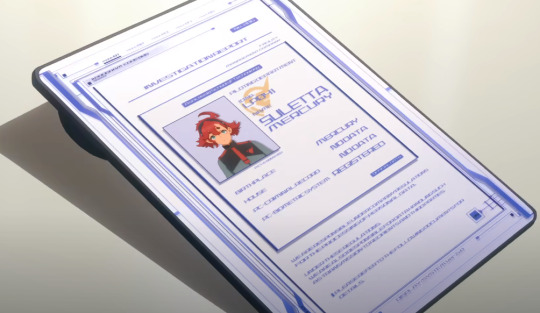
TEXT: (Suletta's Asticassia ID) PILOTING DEPARTMENT ID No: LP-041 SULETTA MERCURY BIRTHPLACE: MERCURY HOUSE: NO DATA PC-CRIMINAL RECORD: NO DATA PC-BIOMETRIC SYSTEM: REGISTERED
(Below) WE ARE RESPONSIBLE UNDER COMPANY REGULATIONS FOR THE PROCESSING OF PERSONAL DATA
UNDER THESE REGULATIONS, WE ARE ALSO RESPONSIBLE FOR DATA HANDLING SUCH AS TRANSMISSION TO RECIPIENTS AND THIRD PARTIES.
PLEASE REFER TO THE FOLLOWING DOCUMENTS FOR DETAILS.
As Suletta is being questioned, we get a brief glimpse at the investigation report the interrogator was looking at before the screen cuts to black when it hits the table. Nothing super interesting here, but Suletta doesn't have a registered criminal record! Yippeeee!

TEXT: CAM: 05 MONITORING CAMERA FACILITY MANAGEMENT COMPANY
Not much to say here, this camera lets us know where Suletta is currently being held. (The Facility Management Company)
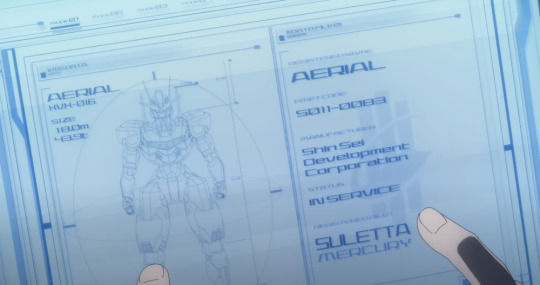
TEXT: (Lefthand Side) AERIAL XVX - 016 SIZE: 18.0m 48.9t
No point discussing the info on the right, we've already seen it, but this gives us a look at Aerial's height and weight.

TEXT: (Top Right) COM DELLING REMBRAN BENERIT GROUP
I only included this to point out that wow the display system devs made some poor choices with the UI here. Dark Blue text on Dark Backgrounds? You'd think the text would automatically lighten but I guess we'll have to wait for Ver 6.0 for that update.
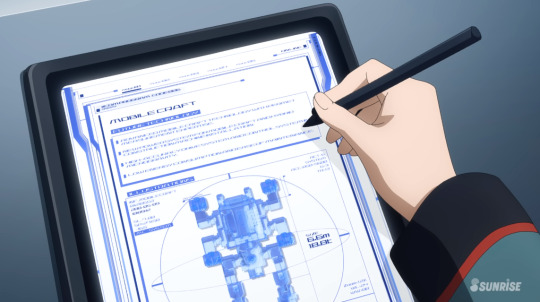
TEXT (Top half) MOBILE CRAFT FUTURE TECHNOLOGY
ADVANCED MOBILE CRAFT TECHNOLOGY WITH PERMET MEASUREMENT EXPERTISE NEW POWER SYSTEM FOR MOBILE CRAFT AND HYBRID CONSTRUCTION MACHINE INSTALLATION HIGH ACCURACY DRIVE SYSTEM AND CONTROL SYSTEM IN MICROGRAVITY LOW ENERGY CONSUMPTION AND EASE OF MAINTENNANCE
No need to discuss the bottom half, its just the height and weight of the MC which we already know. I think it's funny how many classes this school seems to have on the new and improved Mobile Craft from Future Technology. I should probably buy one too. I love you Mobile Craft.
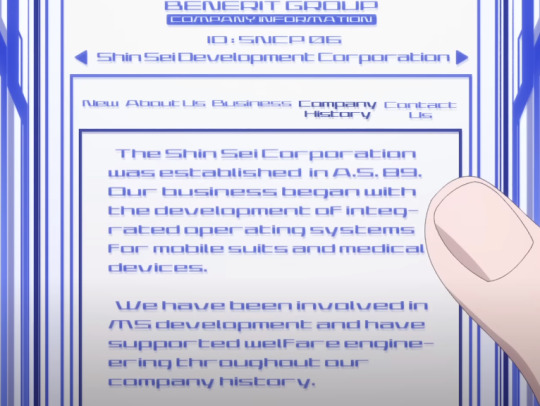

TEXT: (Left Image) The Shin Sei Development Corporation was established in A.S. 89. Our business began with the development of integrated operating systems for mobile suits and medical devices. We have been involved in MS development and have supported welfare engineering throughout our company history.
(Right Image) Ranking: D Sales Ranking (within group companies): 151th (out of) Total 157 companies [Mobile Suit Development] Number of clients: Over 300 companies Yearly patents: Over 200
We get a lot of information about Shin Sei in this scene where Martin looks at the Company History tab on their official website. The most interesting thing being that they were founded in A.S. 89. The Vanadis Incident occured in A.S. 101, and the show proper takes place in A.S. 122, so at some point between 101 and 122, Prospera worked her way up through Shin Sei, eventually becoming its CEO.
Given that Suletta had to have been born around A.S. 105, and that in Cradle Planet, we learn that Prospera had been working within Shin Sei when Suletta was around 6, that places A.S. 111 as the earliest she was involved.
We also learn in Cradle Planet, that when Suletta is around 11, Prospera has recently been promoted within the company, and now has many people working under her. That would be around A.S. 116. When Suletta is 16, that's when Prospera tells her that she's going to school, which would be around A.S. 121, and I think it's safe to assume that she had already become president by then.
SO!! TL;DR!! It's most likely that Prospera became the president of Shin Sei at SOME point between A.S 116 and A.S 121. I'd put it somewhere in the middle, around A.S 119. (Can't wait to find out that they probably just outright state this somewhere and I did all this for nothing....)
ADDENDUM

GOD DAMNIT. I WATCHED ALL OF CRADLE PLANET TO MATH THAT SHIT OUT. WHATEVER. I CAME TO THE SAME CONCLUSION SO I WIN.
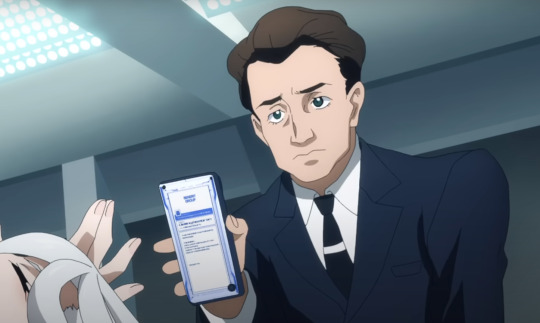
The text is too small to make out, but we DO get a small glimpse at the letter Delling sent to Miorine about unenrolling her from the school. It probably just literally says what the body guard reads out.
I think it says something that Delling doesn't even like, text his daughter. He sends an email through the official Benerit Group email account to her bodyguard who reads it for her. What a cowardly man.

TEXT: (Left) FLUSH (Right) EMERGENCY CALL UNLOCK LOCK
YES the toilet text is important to document stop fucking looking at me like that.

TEXT: NEXT STAGE TOUCH SCREEN TO CONTINUE
I'll leave the explanation of the symbolism of this scene as an exercise for the reader. [Sultry Wink]

TEXT (Above) THIS ELECTRONIC SIGNATURE IS PROOF THAT IT WAS SIGNED BY A REPRESENTATIVE OF THE BENERIT GROUP.
No way to tell what Delling is signing here, but we do get a brief look at his handwriting. It turns out his cursive is really bad, actually!

At the Shin Sei inquiry, Shaddiq shares this graph titled "PMET RETENTION THRESHOLD VALUE", stating that during the duel, Aerial's Permet Influx Values exceeded the standards set by Cathedra.

This graph can be tough to parse, so let me explain it as best I can. The blue line represents Aerial's Permet Retention during the duel. The solid dark line represents the permet retention limit imposed by cathedra on mobile suits. (At around 500) As we can see, while Aerial began the duel underneath that limit, it exceeded it for a moment (presumably when Suletta took over for Miorine and the GUND bits were activated.)
The red line above that is labelled DATA STORM INCIDENT, which is representative of the minimum Permet Retention a Gundam expresses when it is interfacing with a Data Storm. The text on the bottom reads, THIS DATA IS VERY SIMILAR TO GUND FORMAT INCIDENT DATA.
But the key thing to take note of here is that Aerial's chart just BARELY doesn't exceed the DATA STORM INCIDENT graph, meaning that, despite it exceeding Cathedra's standards, it CANNOT be directly proven that Aerial was interfacing with a Data Storm. This is actually what Prospera brings up as her main counterpoint to the accusation.

So the graph is entirely consistent with Prospera's main argument. While she can't prove that Aerial isn't a gundam, nobody else can prove that it is.
Huaaaahh!! Alright!! This one was very DENSE. If you made it all the way through, thank you very much!! As a reward, have some little gay people




[I sprinkle these stills on the ground like bird seed.]
There was definitely a lot of really interesting info in this episode, and while not a lot of it was particularly new, I think it's really a testament to the dedication of keeping things wholly consistent in this world, even for the smallest of things that no normal person watching would even bother noticing.
Also, on the Shin Sei Website, did you notice that they accidentally put 151th instead of 151st?
You can't win em all!
Click here to go to Episode 3! >>
Click here to go to the Masterpost!
36 notes
·
View notes
Text
Exponetly is a leading low-code agency. Our no-code programming solutions are designed for ease of use and accessibility. We focus on attention to detail and leverage our expertise in creating a website without coding.
0 notes